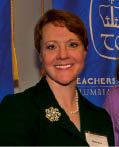Life after Dancing? She's Managing
Rachel Moore navigated a career-ending injury to become Executive Director of the American Ballet Theatre
Rachel Moore navigated a career-ending injury to become Executive Director of the American Ballet Theatre
By Elizabeth Dwoskin
As Executive Director of the American Ballet Theatre, Rachel Moore (M.A., ’94) raises $20 million per year. Yet she considers one of her greatest successes to be the $300,000 gift she secured for replacing the floors in each of the company’s nine dance studios.
“The dancer’s health is important to me,” Moore says. “It’s really important to me.”
That, she says, is because she was “one of them—part of the tribe.” Growing up in California, Moore had one goal: to be a professional ballet dancer. She attended ABT’s summer pre-professional program as a teenager and made it to the parent company in 1984. Four years later, however, an ankle injury ended her career. She took the SATs, went to Brown on a scholarship and got her degree in Ethics and Political Philosophy.
“I was able to step back and look at systems and how they worked,” she says—including the systems that support the arts. That led her to a fellowship at the National Endowment for the Arts, and eventually, to the Arts and Administration Program at Teachers College. In 2006, she became the only former company member—and just the second woman—to lead ABT.
It would be inaccurate to say that Moore’s injury set her on a managerial path. The child of two economists, she became active in the union while still dancing, focusing on equitable salaries and work rules to protect dancers’ health.
“I am sure Rachel is the only E.D. of a ballet company who knows how to do stats from the U.S. census,” says TC Arts and Administration Program Director Joan Jeffri. Moore has taught accounting and finance in the program.
Still, as ABT’s head, Moore—who dresses elegantly in bright colors and retains the athleticism of her dancing days—has earned a reputation for fostering a culture that safeguards the well-being of the dancers. She has sent dancers to a program designed to incubate the next generation of female choreographers. She has expanded therapeutic resources at ABT by building a physical therapy wing. And, with a medical panel advisory board, she created a manual for teaching young students that includes guidelines for recognizing an eating disorder, cleaning the studio’s floors properly, and sensible barre exercises for a 10-year-old body.
Moore also has focused intensely on artistic issues. Concerned that ballet teachers across the country were downgrading their instruction in response to pressure to teach for popular dance competitions, she created ABT’s national training curriculum and teacher certification program in 2006. The program has become a godsend for ABT and for young dancers. Ballet teachers who go through the intense training in either New York or Los Angeles can increase their market value by using the ABT logo in their advertising. So far, 300 teachers have been certified nationwide.
A recipient of TC’s Distinguished Alumni Award in 2006, Moore believes that other dancers will follow her career path.
“Dancers make great managers,” she says. “They can take criticism. They are success-oriented. And they can solve problems.”
Still, Moore would like all young dancers—particularly those at ABT—to stay physically fit. “I want everyone who comes here to have a healthy and joyous experience,” she says. “They don’t need to become professionals. I want them to dance all their lives
Published Thursday, Dec. 16, 2010
